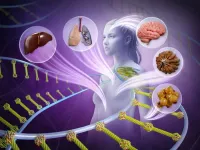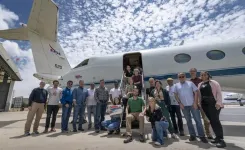(Press-News.org) A University of Ottawa neuroscientist has led a Canadian research team to reveal important new insights into the activation dynamics of neural stem cells (NSCs). These are the stem cells that build our central nervous systems and the self-renewing.
The collaborative team led by the University of Ottawa’s Dr. Armen Saghatelyan aimed to shed light on how neural stem cells integrate a multitude of signals from different cell types in the brain – and how they decode these signals.
These are big questions because how NSCs react to signals in their cellular environment controls whether they remain in their dormant, non-dividing state known as “quiescence” or if they get activated to grow and divide, generating new neurons and glia in the process.
The reported findings, published today in Cell Stem Cell, will certainly be of deep interest to scientists studying a range of adult neurological diseases and aging. In the neural landscape, rousing NSCs from dormancy, where they conserve resources and energy, is key for neural regeneration and brain injury repair.
“These data make it possible to understand better how NSCs can be activated to generate more neurons and glia in order to counteract different neurological disorders and aging. We are currently studying NSCs’ responses for some of these conditions,” says Dr. Saghatelyan, Canada Research Chair in Postnatal Neurogenesis and the new publication’s senior author. (Neurogenesis is the process by which new neurons are formed in the brain.)
Cellular “parent-child” relationship
One avenue of new insight focuses on how stem cells wrap around progeny called “daughter” cells – genetically identical cells created after a parent cell divides.
The team discovered that neural stem cells are in fact receiving constant feedback from their chatty daughter cells. Dr. Saghatelyan likens this to a “parent-child relationship” in which the parent is closely attuned to their child’s feedback.
“Many parents will relate to this since parents like to receive news, or feedback, from their children. Based on this feedback, the parents will either stay reassured that everything is going well or take an action,” he says, comparing this dynamic to the cellular state of quiescence or activation.
Revealing this hidden mechanism is a major finding because it provides an entirely new framework for how to understand this cellular relationship in the human brain.
“Until now it was thought that NSCs only generate progeny and that there is no interaction between them,” Dr. Saghatelyan says. “But our work challenged this notion and showed that there is tight structuro-functional interaction between NSCs and their progeny – and that the number of progeny or the efficiency of progeny-NSC interaction determines whether neural stem cells stay quiescent or get activated to generate neurons and glia.”
In a nutshell, the research team found that a low number of daughter cells leads to activation of neural stem cells, while a large number of offspring keeps them in their typical state of quiescence in the adult brain.
Further, the new study advances our understanding of how NSCs integrate and decode a multitude of signals in space and time. Dr. Saghatelyan says the research unveils for the first time that “calcium signaling in NSCs allows for integration and decoding of all these signals.”
Informing future therapeutics
These new windows of understanding into how NSCs decode signals and how their activation is triggered offers strong potential for informing any future treatments for human neurodevelopmental disorders. Indeed, advancing this potential is the next step for the research collaborators as they explore questions suggested by this work.
“We are now exploring how interactions of NSCs with different cell types in their micro-environment is affected in different physiological and pathological conditions as well as in healthy aging,” says Dr. Saghatelyan, whose Faculty of Medicine research lab focuses on generating new knowledge to help boost neuronal regeneration.
The study – which started at Université Laval where Dr. Saghatelyan’s lab was located until 2022 – was conducted at the uOttawa Faculty of Medicine, where a cutting-edge two-photon imaging system made it possible to assess the functional activity of neural stem cells. Single cell sequencing and spatial transcriptomics were performed by collaborators at University of Toronto and the University of British Columbia. Machine learning collaboration was performed at Université Laval.
The work was supported by the Canadian Institutes of Health Research (CIHR), the Canada Foundation for Innovation (CFI), and investments from the Canada Research Chair program.
END
uOttawa study unveils new insights into how neural stem cells are activated in the adult human brain
A University of Ottawa neuroscientist has led a Canadian research team to reveal important new insights into the activation dynamics of neural stem cells (NSCs). These are the stem cells that build our central nervous systems and the self-renewing
2025-02-06
ELSE PRESS RELEASES FROM THIS DATE:
Cystic fibrosis damages the immune system early on
2025-02-06
Despite new medication, cystic fibrosis often leads to permanent lung damage. Working with an international team, researchers from the Technical University of Munich (TUM) have discovered that the disease causes changes in the immune system early in life, presumably even in newborns. These changes lead to frequent inflammation and are not affected by drugs targeting the altered mucus production.
Cystic fibrosis is caused by hereditary genetic mutations that impair or halt the production of the CFTR protein. The respiratory tract ...
Novel ‘living’ biomaterial aims to advance regenerative medicine
2025-02-06
UNIVERSITY PARK, Pa. — A biomaterial that can mimic certain behaviors within biological tissues could advance regenerative medicine, disease modeling, soft robotics and more, according to researchers at Penn State.
Materials created up to this point to mimic tissues and extracellular matrices (ECMs) — the body’s biological scaffolding of proteins and molecules that surrounds and supports tissues and cells — have all had limitations that hamper their practical applications, according to the team. To overcome some of those limitations, ...
Warding off superbugs with a pinch of turmeric
2025-02-06
In 2017, a tragic incident unfolded in a Nevada hospital. A woman, admitted for pneumonia, tragically succumbed to multiple organ failure and sepsis. The culprit? A strain of bacteria that had developed resistance to a staggering 26 different antibiotics. These superbugs, or antibiotic-resistant bacteria, stand as one of the most pressing public health threats globally.
Joining the effort to fight these deadly pathogens, researchers at Texas A&M have now shown that curcumin, the compound that gives turmeric its characteristic bright yellow color, can potentially be used to reduce antibiotic resistance.
The ...
Ophthalmic complications in patients on antidiabetic GLP-1 medications are concerning neuro-ophthalmologists
2025-02-06
BUFFALO, N.Y. — A small percentage of patients taking the extraordinarily popular GLP-1 medications have experienced vision problems, but a direct causal link with the drugs has not been established. That is the conclusion of a retrospective study published online on Jan. 30 in JAMA Ophthalmology.
The study focused on nine patients who had experienced vision problems while using semaglutide (brand names Wegovy and Ozempic) and tirzepatide (brand names Mounjaro and Zepbound).
The paper is one of several in the past ...
Physicians committee research policy director speaks today at hearing on taxpayer funded animal cruelty
2025-02-06
WASHINGTON, D.C. — Research Policy Director Elizabeth Baker from the Physicians Committee for Responsible Medicine, a national medical ethics and health advocacy group of 17,000 physicians, spoke today, Feb. 6, at a Congressional hearing focused on ending federally funded animal cruelty in research.
The U.S. House Oversight and Government Reform Subcommittee on Cybersecurity, Information Technology, and Government Innovation Chairwoman Nancy Mace (R-S.C.) announced the hearing in a news release on Monday, with plans to evaluate current animal cruelty funded by the federal government and explore opportunities ...
New technology lights way for accelerating coral reef restoration
2025-02-06
COLUMBUS, Ohio – Scientists have developed a novel tool designed to protect and conserve coral reefs by providing them with an abundance of feeding opportunities.
The device, dubbed the Underwater Zooplankton Enhancement Light Array (UZELA), is an autonomous, programmable underwater light that works to draw in nearby zooplankton, microscopic organisms that coral feed on.
After testing the submersible on two species of coral native to Hawaii over six months, researchers found that UZELA could ...
Electroencephalography may help guide treatments for language disorders
2025-02-06
Electroencephalography (EEG) may offer a more accessible alternative to functional magnetic resonance imaging (fMRI) for guiding transcranial direct current stimulation (tDCS) when treating aphasia. Researchers from Institute of Science Tokyo found an 80% agreement between EEG and fMRI in identifying brain regions activated during language tasks. Furthermore, EEG-guided tDCS improved picture-naming speed in participants, indicating its potential for innovative therapies in language disorders.
Many neurological disorders are directly linked to damage or deterioration in specific regions of the brain. For example, ...
Multinational research project shows how life on Earth can be measured from space
2025-02-06
Measurements and data collected from space can be used to better understand life on Earth.
An ambitious, multinational research project funded by NASA and co-led by UC Merced civil and environmental engineering Professor Erin Hestir demonstrated that Earth’s biodiversity can be monitored and measured from space, leading to a better understanding of terrestrial and aquatic ecosystems. Hestir led the team alongside University of Buffalo geography Professor Adam Wilson and Professor Jasper Slingsby from the University ...
Essential genome of malaria parasite Plasmodium knowlesi mapped
2025-02-06
Embargoed for release: Thursday, February 6, 2025, 2:00 PM ET
Key points:
Comprehensive genetic mapping of Plasmodium knowlesi, a zoonotic parasite that causes malaria, has revealed the genes required for malaria infection of the blood, and those driving drug resistance.
By identifying specific druggable targets and determinants of resistance, the map provides insights that could help the development of new therapeutics.
Boston, MA—A new, comprehensive map of all the genes essential for blood infections in Plasmodium knowlesi (P. ...
Ice streams move due to tiny ice quakes
2025-02-06
In brief:
• In Greenland, an international team of researchers led by ETH Zurich has discovered that countless tiny ice quakes take place deep inside ice streams.
• These quakes are responsible for the fact that ice streams also move with a continuous stick-slip motion and not only like viscous honey as previously considered.
• The researchers recorded seismic data from inside the ice stream using a fibre-optic cable in a 2,700-metre deep borehole.
The ...
LAST 30 PRESS RELEASES:
Making lighter work of calculating fluid and heat flow
Normalizing blood sugar can halve heart attack risk
Lowering blood sugar cuts heart attack risk in people with prediabetes
Study links genetic variants to risk of blinding eye disease in premature infants
Non-opioid ‘pain sponge’ therapy halts cartilage degeneration and relieves chronic pain
AI can pick up cultural values by mimicking how kids learn
China’s ecological redlines offer fast track to 30 x 30 global conservation goal
Invisible indoor threats: emerging household contaminants and their growing risks to human health
Adding antibody treatment to chemo boosts outcomes for children with rare cancer
Germline pathogenic variants among women without a history of breast cancer
Tanning beds triple melanoma risk, potentially causing broad DNA damage
Unique bond identified as key to viral infection speed
Indoor tanning makes youthful skin much older on a genetic level
Mouse model sheds new light on the causes and potential solutions to human GI problems linked to muscular dystrophy
The Journal of Nuclear Medicine ahead-of-print tip sheet: December 12, 2025
Smarter tools for peering into the microscopic world
Applications open for funding to conduct research in the Kinsey Institute archives
Global measure underestimates the severity of food insecurity
Child survivors of critical illness are missing out on timely follow up care
Risk-based vs annual breast cancer screening / the WISDOM randomized clinical trial
University of Toronto launches Electric Vehicle Innovation Ontario to accelerate advanced EV technologies and build Canada’s innovation advantage
Early relapse predicts poor outcomes in aggressive blood cancer
American College of Lifestyle Medicine applauds two CMS models aligned with lifestyle medicine practice and reimbursement
Clinical trial finds cannabis use not a barrier to quitting nicotine vaping
Supplemental nutrition assistance program policies and food insecurity
Switching immune cells to “night mode” could limit damage after a heart attack, study suggests
URI-based Global RIghts Project report spotlights continued troubling trends in worldwide inhumane treatment
Neutrophils are less aggressive at night, explaining why nighttime heart attacks cause less damage than daytime events
Menopausal hormone therapy may not pose breast cancer risk for women with BRCA mutations
Mobile health tool may improve quality of life for adolescent and young adult breast cancer survivors
[Press-News.org] uOttawa study unveils new insights into how neural stem cells are activated in the adult human brainA University of Ottawa neuroscientist has led a Canadian research team to reveal important new insights into the activation dynamics of neural stem cells (NSCs). These are the stem cells that build our central nervous systems and the self-renewing




